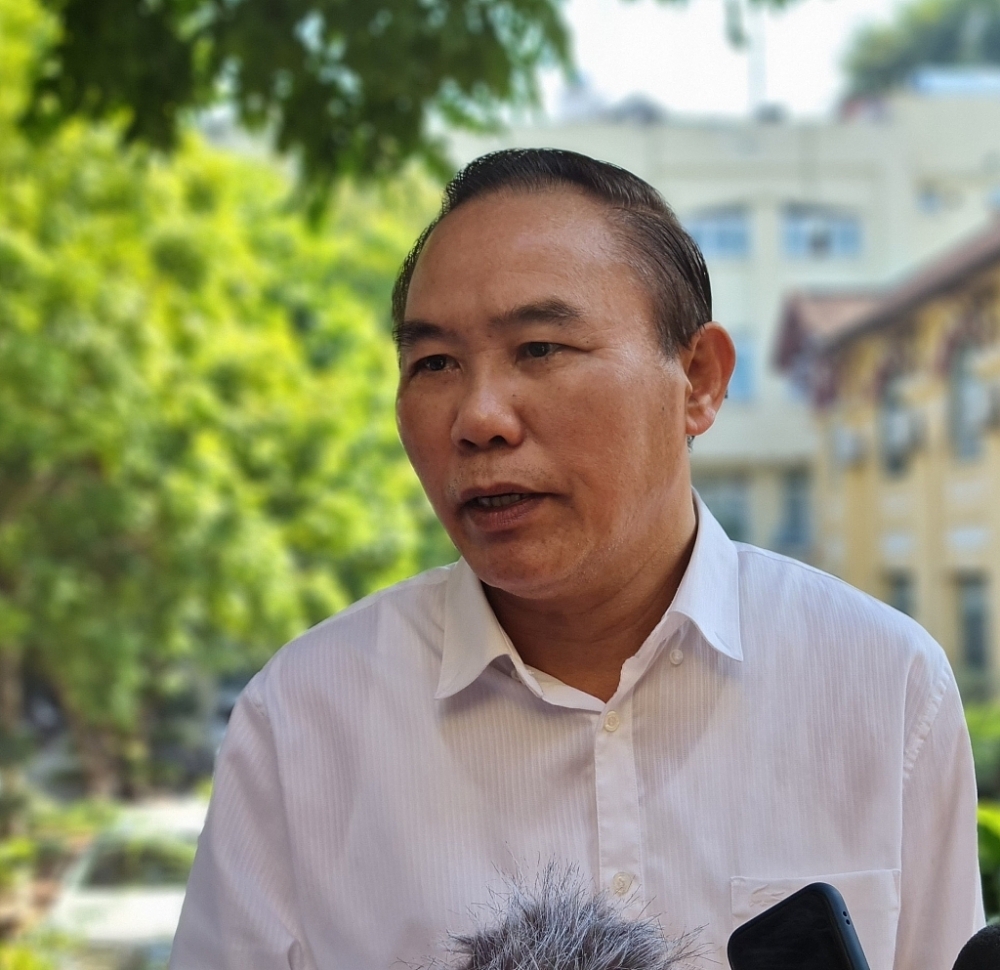 |
| Minister of Agriculture and Rural Development (MARD) Phung Duc Tien |
After a continuous decline, live hog prices have started to rise again in recent days. How does the Deputy Minister evaluate this trend?
The scale of Vietnam’s pig herd now reaches 28.2 million heads. In terms of price, there are many aspects to consider.
Amid the Covid-19 pandemic, consumption decreased greatly, typically in Ho Chi Minh City.
Normally, Ho Chi Minh City consumes 1,600 tons of food a day. With the implementation of social distancing, consumption in factories, schools, hotels, restaurants was completely affected, consumption decreased by about 25-35%.
Ho Chi Minh City can only produce 5-10% of its own food; the rest is brought up by the western provinces. In the past few months, due to the social distancing and pandemic prevention, the food supply in localities has been chaotic and food cannot be transported to Ho Chi Minh City.
Thus, there is a shortage of consumption places, and a surplus of production places which leads to a backlog of livestock and poultry, especially pigs and industrial chickens. There has been a significant backlog of pork production that has not been consumed in the past few months. Normally, raising pigs only 1.1-1.2 quintals can be sold, but the raising time had to prolong, the percentage of fat has increased, leading to a decrease in selling price.
At present, the pandemic prevention and control work has had positive results, consumption has returned, and the backlog has been gradually resolved. This year, it is expected that the total pork production will reach about 3.8 million tons, equivalent to 2018. In recent days, pork prices have increased continuously. When the disease has been controlled, the circulation returns to normal, and social demand gradually recovers, prices will return to reasonable levels in the coming weeks.
Some argue that in the past few months, in addition to the influence of the Covid-19 pandemic, one of the reasons for the deep drop in pig prices is the inadequate forecasting of the livestock industry. What is the view of the Deputy Minister?
In 2019, the price of pigs dropped sharply due to the African swine fever epidemic. The Ministry of Agriculture and Rural Development calculated exactly and confirmed that by the end of the third quarter of 2020, the price of pork would return to normal. Under normal conditions, African swine fever can be controlled, and the forecast is very accurate.
However, according to the Department of Livestock Production, in recent months, there have been only 1.5 million porker pigs. The impact of the Covid-19 pandemic disrupted all plans. It is difficult to predict accurately in the context of the complicated development of the Covid-19 pandemic, even with mutations.
On October 11, 2021, the Government issued Resolution 128/NQ-CP promulgating temporary regulations “safely adapting, flexibly, effectively controlling the Covid-19 pandemic”. It clearly states that the Ministry of Agriculture and Rural Development actively seeks sources for consumption of agricultural products until the harvest period, especially in key livestock and agricultural production areas, and closely coordinates with the Ministry of Transport and the Ministry of Industry and Trade, and localities to facilitate the transportation and consumption of agricultural products. How has this spirit been realized, creating changes in the livestock sector, Sir?
Previously, during social distancing, there were no agreements in implementing documents about essential items being circulated in localities. Although the Prime Minister concluded that only prohibited goods could not be circulated, the rest could be circulated normally, localities have not strictly implemented it, still created negative examples and causing difficulties.
Up to now, sub-committees such as: Special sub-committee, production sub-committee, circulation sub-committee, etc., have been established to control the dismantling of circulation and resumption of normal operation. However, in order to run smoothly from central to local levels, the Prime Minister directed ministries and branches to focus on guiding Resolution 128/NQ-CP and Decision No. 4800/QD-BYT dated October 12/ 2021 of the Ministry of Health on the promulgation of the Interim Guidance on Medical Professionals for the implementation of Resolution No. 128/NQ-CP (guideline 4800).
The Prime Minister has directed localities to update four levels of pandemic risk: level 1, 2, 3, and 4 and there is only one formal directive to fight the pandemic. Units and localities that promulgate other regulations must consult the Prime Minister. As a result, the circulation situation was restored, and the demand for agricultural products, including livestock products, increased markedly.
I believe that in the future, when the circulation is smoother, not only agriculture, forestry and fishery will be guaranteed to serve the domestic market of 100 million people, but the whole industry’s exports will also increase.
What solutions will the Ministry of Agriculture and Rural Development (MARD) promote to avoid breaking the supply chain in nurturing, ensuring domestic supply-demand and the required content of exports in the near future?
Currently, 52% of pig productions are from households and small farms. In order to promote export and ensure the chain, it is necessary to connect these small farms in the spirit of the Law on Livestock. This also leads to an increase in output of product.
In addition, the Ministry of Agriculture and Rural Development has created a favorable environment to coordinate with localities for large enterprises to invest in the livestock industry chain. For example, CP Group has just inaugurated a high technology slaughterhouse in Binh Phuoc with a total investment of US$250 million, and a disease-free area from seed, nutritional food, farming, slaughtering, processing and exporting to markets.
Besides, Masan Group has also invested in slaughterhouses and raw material areas in Ha Nam and surrounding areas with a total capital of VND1,600 billion. At the same time, a factory of VND1,800 billion in Long An and other enterprises such as Vinamilk, Dabaco, Japfa, also follow this direction. I believe that many food chains from breeding, slaughtering, preliminary processing, processing and exporting will be built in the coming years.
Thank you, Sir!
Thanh
